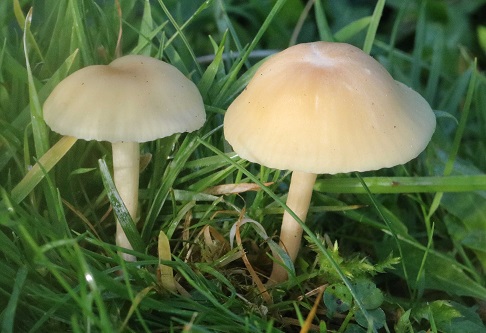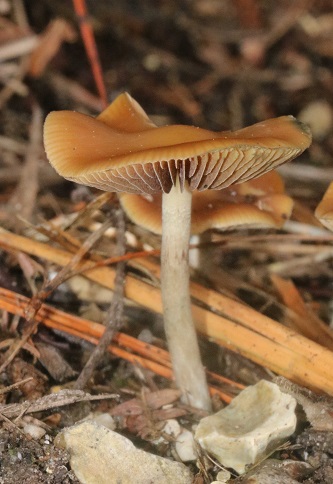Exbury
Sun 17 Nov 2024
Field event ID HF2420
OS Grid areas: SU4200
Report: As usual, our annual visit to these beautiful gardens proved popular with our members and we were pleased to renew acquaintances with our guides for the day, Linda and Juliet.
The mown grass lawns provided considerable interest with a nice array of waxcaps, although many were passed their best. Notable amongst these were Cuphophyllus russocoriaceus (Cedarwood Waxcap) and Porpoplomopsis calyptriformis (Pink Waxcap). There were also some luxuriant clumps of Clavulinopsis corniculata (Meadow Coral) as well as Rickenella schwartzii (Collared Mosscap), Dermoloma cuneifolium (Crazed Cap) and Handkea utriforme (Mosaic Puffball).
A small, greyish species with a wavy edge to the cap and a woolly stipe caused some head-scratching but it was later determined as Arrhenia acerosa (Moss Oysterling). A number of earthtongue species were in evidence, including Microglossum olivaceum (Olive Earthtongue).
The highlight of the mown grassland was Clavulina zollingeri (Violet Coral), a beautiful little species that one of our members, Julie, had found here in October but thankfully it was still hanging on to impress the group. It has a north-western distribution in the UK so was an extremely rare find for Hampshire.
Switching our attention to the flowerbeds and trackways added more interesting finds including Tricholoma terreum (Grey Knight), Tricholoma batschii, Macrocystidia cucumis (Cucumber Cap), Conocybe rugosa (Wrinkled Conecap), Cyathus striatus (Striated Bird’s Nest), Psilocybe cyanescens (Blueleg Brownie), Coprinopsis lagopus (Hare’s-foot Inkcap), Volvopluteus gloiocephalus (Stubble Rosegill), Aleuria aurantia (Orange Peel Fungus) and Geastrum triplex (Collared Earthstar).
Some small bracket fungi on a conifer stump which were oozing amber droplets proved to be Ischnoderma benzoinum (Benzoin Bracket), whilst another white bracket with clear droplets on the surface was identified as Postia guttulata.
Our walk back was interrupted by some impressive Helvella crispa (White Saddle) and Tricholoma saponaceum var. squamosum (Soapy Knight). This variety had an olive-toned, dark brown cap and a distinctive dark-scaled stipe.
Species recorded: Aleuria aurantia (Orange Peel Fungus), Amanita pantherina (Panthercap), Apioperdon pyriforme (Stump Puffball), Arrhenia acerosa (Moss Oysterling), Bolbitius titubans var. titubans (Yellow Fieldcap), Byssomerulius corium (Netted Crust), Cantharellus tubaeformis (Trumpet Chanterelle), Clavaria fragilis (White Spindles), Clavaria fumosa (Smoky Spindles), Clavulina coralloides (Crested Coral), Clavulinopsis corniculata (Meadow Coral), Clavulinopsis luteoalba (Apricot Club), Clitocybe nebularis (Clouded Funnel), Coprinellus micaceus (Glistening Inkcap), Coprinopsis lagopus (Hare'sfoot Inkcap), Cordyceps militaris (Scarlet Caterpillarclub), Cortinarius roseonudipes, Craterellus cornucopioides (Horn Of Plenty), Cuphophyllus pratensis var. pratensis (Meadow Waxcap), Cuphophyllus virgineus var. virgineus (Snowy Waxcap), Dermoloma cuneifolium (Crazed Cap), Geastrum triplex (Collared Earthstar), Geoglossum fallax (Deceptive Earthtongue), Gliophorus irrigatus (Slimy Waxcap), Gliophorus psittacinus (Parrot Waxcap), Gymnopilus junonius (Spectacular Rustgill), Gymnopilus penetrans (Common Rustgill), Helvella crispa (White Saddle), Helvella lacunosa (Elfin Saddle), Hemimycena tortuosa (Dewdrop Bonnet), Heterobasidion annosum (Root Rot), Hygrocybe ceracea (Butter Waxcap), Hygrocybe chlorophana (Golden Waxcap), Hygrocybe coccinea (Scarlet Waxcap), Hygrocybe conica (Blackening Waxcap), Hymenochaete rubiginosa (Oak Curtain Crust), Hymenopellis radicata (Rooting Shank), Hypholoma fasciculare var. fasciculare (Sulphur Tuft), Infundibulicybe geotropa (Trooping Funnel), Inocybe griseolilacina (Lilac Leg Fibrecap), Inocybe mixtilis, Laccaria laccata (Deceiver), Laccaria tortilis (Twisted Deceiver), Lactarius blennius (Beech Milkcap), Lactarius omphaliiformis, Lepiota cristata (Stinking Dapperling), Lepiota xanthophylla, Lepista nuda (Wood Blewit), Leratiomyces ceres (Redlead Roundhead), Leucogyrophana mollusca, Lycoperdon perlatum (Common Puffball), Lycoperdon utriforme (Mosaic Puffball), Lyophyllum fumosum, Macrocystidia cucumis (Cucumber Cap), Microglossum rufescens, Mycena amicta (Coldfoot Bonnet), Mycena vitilis (Snapping Bonnet), Panaeolina foenisecii (Brown Mottlegill), Parasola plicatilis (Pleated Inkcap), Phaeolus schweinitzii (Dyer's Mazegill), Pholiotina rugosa, Pluteus salicinus (Willow Shield), Pluteus salicinus (Willow Shield), Porpolomopsis calyptriformis (Pink Waxcap), Postia guttulata, Rickenella swartzii (Collared Mosscap), Russula nobilis (Beechwood Sickener), Russula ochroleuca (Ochre Brittlegill), Russula parazurea (Powdery Brittlegill), Russula turci (Pirate Brittlegill), Scleroderma areolatum (Leopard Earthball), Scleroderma citrinum (Common Earthball), Serpula himantioides, Steccherinum ochraceum, Tricholoma batschii, Tricholoma saponaceum var. squamosum, Tricholoma terreum (Grey Knight), Volvopluteus gloiocephalus (Stubble Rosegill)
A full species list with further details can be seen at the Fungal Records Database of Britain and Ireland (FRDBI). Please contact us if you need a user ID.















